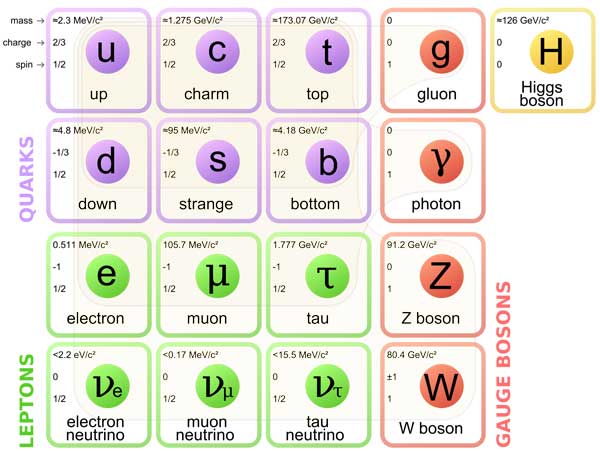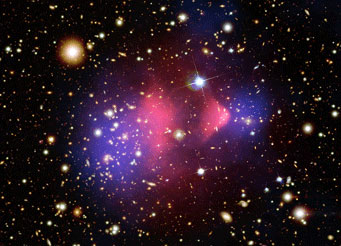Astronomy - Does a Fifth Force Permeate the Universe?
A team of theoretical physicists thinks a fifth force could explain an anomaly spotted in a nuclear physics experiment. If true, it could have huge ramifications for particle physics and dark matter — but that’s a pretty big if.

The electron-positron spectrometer at the Institute for Nuclear Research in Debrecen, Hungary, which has supposedly found evidence for a new particle.
MTA-Atomki
MTA-Atomki
Last year nuclear physicists in Hungary were running an experiment, watching excited beryllium-8 atoms’ radioactive decay, when they saw something strange. These atoms shed their extra energy by releasing high-energy photons, which in turn immediately produce an electron and a positron traveling in the same direction. But for every millionth decay, the team noticed the two particles sputtering out in opposite directions.
The team couldn’t explain the data using any known physical phenomena. So instead the scientists speculated that excited beryllium-8 nuclei every now and then release a new particle — one not included in the Standard Model of physics — rather than a photon. That new particle then produces the electron-positron pairs that speed away in opposite directions.
In a paper published to the arXiv preprint server last week, Jonathon Feng (University of California, Irvine) and his colleagues took the result a step further. Though they also suggest that the observation is due to a new particle — in this case, one that’s roughly 30 times heavier than an electron — they don’t think it’s a run-of-the-mill one. Instead, this new particle, known as a gauge boson, would carry one of the fundamental forces that provide communication between other particles.
And there’s more: Feng and his colleagues think the force this boson carries goes beyond the four fundamental forces we already know about — gravity, electromagnetism, and the strong and weak nuclear forces — and it may even be “dark,” interacting only with dark matter particles.
Wild Implications …

The Standard Model of Physics predicts a limited number of particles and forces. Physicists might have found a new particle — beyond what the Standard Model predicts — that implies the existence of a fifth fundamental force. (Click for larger version.)
MissMJ / Wikimedia Commons
MissMJ / Wikimedia Commons
Dark matter — the mysterious substance that composes roughly 85% of the universe’s matter — continues to defy explanation. Most astronomers favor the model of dark matter that portrays it as a single particle called a Weakly Interacting Massive Particle (WIMP) because it likely interacts with others of its kind and normal matter very little or perhaps not at all.
But in recent years, and in the face of nondetections in physicists’ labs around the world, a second model has gained traction. In this scenario, a dark force governs dark matter, where the particles interact with each other via the exchange of a dark boson. Feng and his colleagues suspect that the particle seen in the nuclear physics experiment is this dark boson.
If that’s true, the observations might actually bring dark matter, well, out of the dark. Because the boson appears to interact (albeit weakly) with normal matter by producing the electron-positron pairs, dark matter must be linked to normal matter. Some models, Feng says, actually predict that the dark force can leak over into our world. So it’s not crazy to suggest that particles like electrons and positrons could actually feel this dark force.
“And that would be extraordinarily exciting because then there would be a window into exploring this dark world,” Feng says. “We're only a tiny wedge in the universe, we're only 15% of the universe — it would be great to have some way to view the other 85% of the universe.”
This scenario could even help solve some problems with dark matter. Computer simulations, for example, show that dark matter slips into the centers of galaxies so easily that it creates cores far denser than the ones astronomers actually observe. These simulations typically assume dark matter is made of WIMPs. Although this is arguably physicists’ most popular idea for what dark matter is, because these particles barely interact with themselves they glide past one another too easily, until they build a core that’s far too dense.
One way to overcome this problem is to change the type of dark matter used. And a particle that’s linked to a dark field — like the one that Feng and his colleagues postulate — could do just that. This type of dark matter would interact with itself until it reached a point where it would stop collapsing and therefore keep the cores from growing too dense. But it isn’t the only solution, notes David Harvey (Observatoire de Sauverny), who wasn’t involved in the study. It’s just as likely, he says, that astronomers don’t understand black holes or exploding stars as well as they think they do.
… If It’s True

The Bullet Cluster is a textbook example of the evidence for dark matter. In the merging galaxy clusters, hot gas (pink) sloshes around the galaxies (red, green, blue) that are anchored in dark matter (purple).
X-ray: NASA / CXC / CfA / M.Markevitch et al.; Lensing Map: NASA / STScI / ESO WFI / Magellan / U.Arizona / D.Clowe et al.; Optical: NASA / STScI / Magellan / U.Arizona / D.Clowe et al.
X-ray: NASA / CXC / CfA / M.Markevitch et al.; Lensing Map: NASA / STScI / ESO WFI / Magellan / U.Arizona / D.Clowe et al.; Optical: NASA / STScI / Magellan / U.Arizona / D.Clowe et al.
Not all astronomers, however, have joined the dark side. Even Bartosz Fornal (University of California, Irvine), a co-author on the recent paper, admits that there is no answer yet. He and his colleagues have simply put forth one explanation. “We are cautiously optimistic,” he says. “This might be an experimental error. There might be some nuclear physics effect that we don't understand yet. But it turns out that this interpretation fits the data pretty well.”
Still, whether that data is reliable is an open question. Physicist Oscar Naviliat-Cuncic (Michigan State University) told Quanta Magazine that he mistrusts the data enough to seriously doubt this report. After digging into the history and credentials of the Hungarian team, he discovered that Fokke de Boer, a Dutch physicist who led their experiments from 2001 to 2005, once reported more than 10 candidate bosons based on multiple anomalies in the data — a huge red-flag because making one earth-shattering discovery is hard enough, let alone 10. Remember that it took years of international effort to discover the Higgs boson.
Don Lincoln (Fermi National Accelerator Laboratory and University of Notre Dame), showed similar concerns in astory he wrote for Live Science. Although the pandemonium of 10 bosons disappeared when the team upgraded their experimental apparatus, the team continued to see new anomalies, which opened up the floodgates for new physics. The two papers that preceded the latest one, for example, also showed comparable anomalies, both of which were later falsified. It’s improbable to claim so many anomalies, he says. Try as they might, research scientists tend to spend most of their careers confirming existing theories.
Even if you accept the data, the latest theory isn’t favored from a purely philosophical point of view. “Whenever you encounter something that you can't explain, you want to make the fewest number of changes,” says Douglas Clowe (Ohio University), who wasn’t involved in the study. “So if we just create a new particle that is consistent with the standard model that's easier than trying to introduce a fifth force.” WIMPs, for example, are a simple extension of the standard model. But a fifth force is a tad more dramatic, he says.
Still, it’s plausible, Clowe says. “There's nothing in the physics that I see that's wrong. it just isn't necessarily correct.”
All agree that physicists will need a lot more data before they can begin to confirm any one theory. “As in all science, no one claim is sufficient for proof,” Feng says. Luckily because the particle is so light (laboratories have had the energies required to produce it since the 1950s), there are likely a dozen experiments in the world that could search for this particle today — and many, Feng says, have already joined the hunt.
“I'm quite sure the story will be much clearer in two or three years, maybe even sooner,” Feng says.
No comments:
Post a Comment